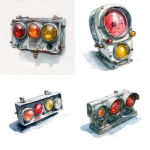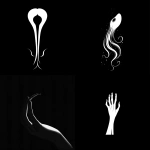Explore the Best AI Image Gallery

Pixels on Skin: Exploring the Impact of AI-Generated Images in Design
The design world is on the cusp of a revolution. Artificial intelligence (AI), specifically AI image generation, is rapidly changing the creative landscape, blurring the lines between human and machine ingenuity. From generating unique visuals to streamlining workflows, AI-powered tools are empowering designers with unprecedented capabilities. This blog post explores the multifaceted impact of AI images in design, examining its potential uses, ethical considerations, and future trends.
A New Arsenal for Designers
AI image generation tools leverage advanced algorithms trained on massive datasets of images to produce stunning visuals on demand. These tools offer a vast array of applications for designers across various disciplines:
- Concept Development: Quickly generate multiple visual concepts based on textual descriptions, helping designers explore diverse ideas and refine their vision.
- Asset Creation: Produce high-quality graphics, illustrations, and icons to enhance design projects, saving time and resources.
- Customization: Personalize designs by generating variations of existing assets or creating unique elements tailored to specific client requirements.
- Prototyping: Visualize design concepts in a realistic manner, allowing for quicker iterations and feedback during the development process.
Ethical Considerations: Navigating the Uncharted Territory
While AI image generation presents exciting opportunities, it also raises crucial ethical considerations that require careful attention:
- Copyright and Intellectual Property: Questions arise regarding ownership and copyright of AI-generated images, particularly when they are based on existing copyrighted material.
- Bias and Representation: AI models can perpetuate societal biases present in the training data, leading to the generation of biased or stereotypical imagery. Its crucial to ensure fairness and inclusivity in AI-powered design tools.
- Transparency and Accountability: The decision-making processes of AI algorithms can be complex and opaque. Establishing transparency and accountability mechanisms is essential for building trust and addressing potential misuse.
The Future of Design: A Collaborative Landscape
The future of design lies in a collaborative relationship between humans and AI. AI will augment human creativity, enabling designers to achieve new levels of innovation and efficiency. However, the human element remains crucial for providing artistic vision, critical thinking, and ethical guidance.
AI image generation tools are poised to revolutionize the design industry, offering exciting possibilities and challenges. By embracing responsible development practices, addressing ethical concerns, and fostering collaboration between humans and AI, we can unlock the full potential of this transformative technology and shape a future where creativity knows no bounds.
Key Takeaways
- AI-generated images are transforming design workflows, empowering designers with new tools for concept development, asset creation, and prototyping.
- Ethical considerations surrounding copyright, bias, and transparency must be addressed to ensure responsible and equitable use of AI in design.
- The future of design lies in a collaborative partnership between humans and AI, leveraging the strengths of both to push creative boundaries.

](https://images.ai-img.art/thumbnails/150/3e8c063b4357fc743a3c6e49a3145ee31b2dcecc018c38d2db8f97bf3e3fda3f.webp)

](https://images.ai-img.art/thumbnails/150/8c320ce9aefbbb5b9ec5fd4e1d0fba7388f0fff5b6c2e2f14077cad3008f291d.webp)









](https://images.ai-img.art/thumbnails/150/3c5dc62bba83cc9919c20ebfec8430d31e821cef586a2753dd85ef26d77d480a.webp)



](https://images.ai-img.art/thumbnails/150/1accb5453f2335686b162f0a879c7ce73a18516a33868f214a16bdaf95beeb5a.webp)
](https://images.ai-img.art/thumbnails/150/1d7b3a908141474d50d90721c394db29c0cb5404d685ae70ea60430c18e905b7.webp)




